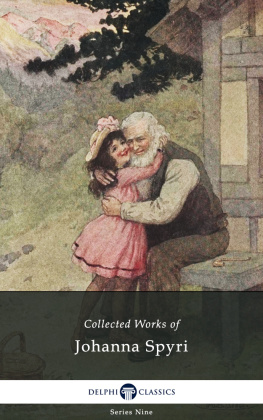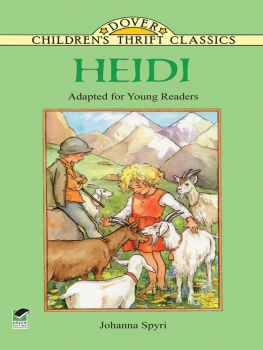
The Collected Works of
JOHANNA SPYRI
(1827-1901)

Contents

Delphi Classics 2018
Version 1


Browse our Main Series

Browse our Ancient Classics

Browse our Poets

Browse our Art eBooks

Browse our Classical Music series

The Collected Works of
JOHANNA SPYRI

By Delphi Classics, 2018
COPYRIGHT
Collected Works of Johanna Spyri

First published in the United Kingdom in 2018 by Delphi Classics.
Delphi Classics, 2018.
All rights reserved. No part of this publication may be reproduced, stored in a retrieval system, or transmitted, in any form or by any means, without the prior permission in writing of the publisher, nor be otherwise circulated in any form other than that in which it is published.
ISBN: 978 1 78656 110 7
Delphi Classics
is an imprint of
Delphi Publishing Ltd
Hastings, East Sussex
United Kingdom
Contact: sales@delphiclassics.com

www.delphiclassics.com
Interested in classic childrens literature?
Then youll love these eBooks:

These comprehensive editions are beautifully illustrated with the original artwork of some of the greatest children stories ever told, as well as offering a dazzling array of Delphi bonus features. Now you can rediscover the magic of these eternal classics on your eReader!
Explore Classic Childrens eBooks
Heidi

The birthplace of Spyri Hirzel, Switzerland

Spyri, aged 22
Heidi: Marian Edwardes translation, 1910

Translated by Marian Edwardes and Illustrated by Jessie Willcox Smith
Written by the Swiss author Johanna Spyri in German, the beloved childrens book Heidi was originally published in two parts as Heidi: Her Years of Wandering and Learning ( Heidis Lehr- und Wanderjahre ) and Heidi: How She Used What She Learned ( Heidi kann brauchen, was sie gelernt hat ). The first part appeared in 1880, while the second appeared the following year. Written as a book for children and those who love children as stated in its subtitle, the novel concerns events in the life of a young girl in her grandfathers care in the Swiss Alps, largely inspired by Spyris own youthful summers spent in Chur in the Swiss canton of Grisons.
The plot introduces Heidi as an orphaned girl initially raised by her aunt Dete in Maienfeld, Switzerland, after the early deaths of her parents. Dete brings five-year-old Heidi to her paternal grandfathers house, up the mountain from the Drfli (a small village in Swiss German). He has been at odds with the villagers and embittered against God for years and lives in seclusion on the alm, earning him the nickname Uncle Alp. Though at first he resents Heidis arrival, the girls intelligence and cheerful demeanour earn his genuine, yet reserved affection. Heidi enthusiastically befriends her new neighbours, Peter the goatherd, his mother, Bridget, and his blind maternal grandmother. With each season that passes, the mountaintop inhabitants become more attached to Heidi.
Three years later, Dete returns to take Heidi to Frankfurt to be a hired ladys companion to a wealthy girl named Clara Sesemann, who is regarded as an invalid. The girl is charmed by Heidis easy friendliness and is amused by the various mistakes brought about by her lack of experience with city life. However, the Sesemanns strict housekeeper, Frulein Rottenmeier, views the household disruptions as wanton misbehaviour and places Heidi under more restraint. Soon, Heidi becomes terribly homesick and grows alarmingly pale and thin
The novel has inspired more than fifteen film or television productions, causing the story to become famous around the world. Notable versions include the 1937 motion picture starring Shirley Temple in the title role, a 1968 television movie starring Jennifer Edwards with Maximilian Schell and Michael Redgrave and Heidi, Girl of the Alps , a 1974 Japanese anime series directed by Isao Takahata. A stage musical adaptation of Heidi with book and lyrics by Francois Toerien, music by Mynie Grov and additional lyrics by Esther von Waltsleben, premiered in South Africa at the Klein Karoo National Arts Festival in 2016.
Heidiland, named after Spyris Heidi books, is an important tourist area in Switzerland, popular especially with Japanese and Korean tourists. Maienfeld is the centre of what is called Heidiland; one of the villages, formerly called Oberrofels, was actually renamed Heididorf.
This translation of the novel is by Marian Edwardes, a British editor and compiler, who is also credited as a co-translator of Grimms Fairy Tales . Although early editions of Heidi from Dent and Dutton do not credit a translator, they do feature a foreword signed M. E.. First appearing in 1910, Edwardes unaccredited translation was released in many other editions during the twentieth century, though two stand out as the cause of its popularity among English readers. The first instance is the edition published by McKay in 1922 in America, with illustrations by Jessie Willcox Smith, a well-known artist that had been a student of Howard Pyle. By the time Smith came to Heidi , she had not only already illustrated many classics, including Stevensons A Childs Garden of Verses , MacDonalds The Princess and the Goblin and Alcotts Little Women , but her style was familiar, since her paintings of children often appeared on the cover of Good Housekeeping and other magazines. For many older readers of Heidi, Smiths images are permanently tied to the novel.
Next page




























